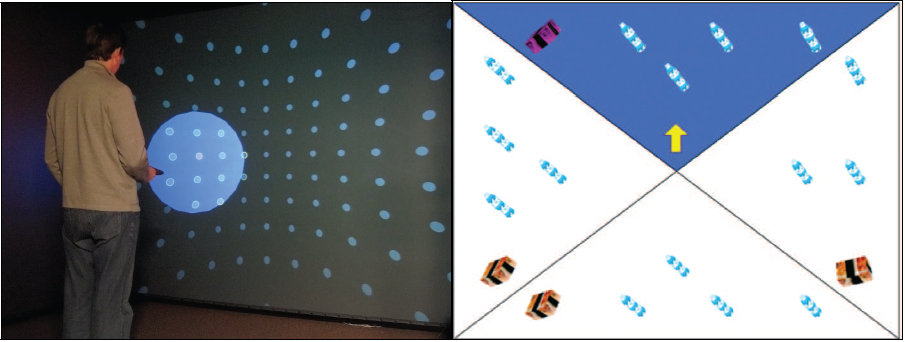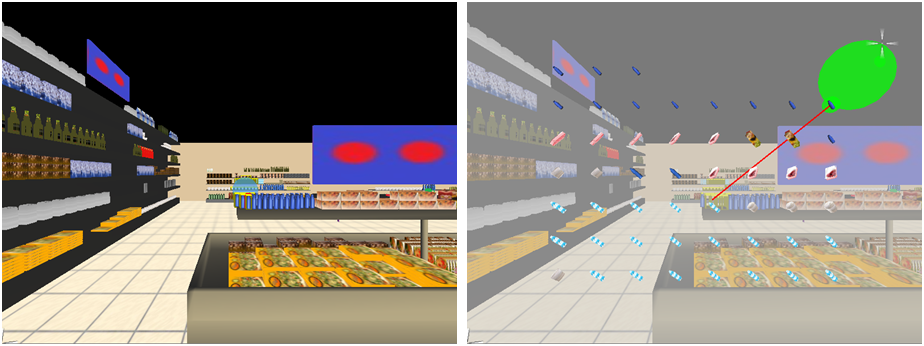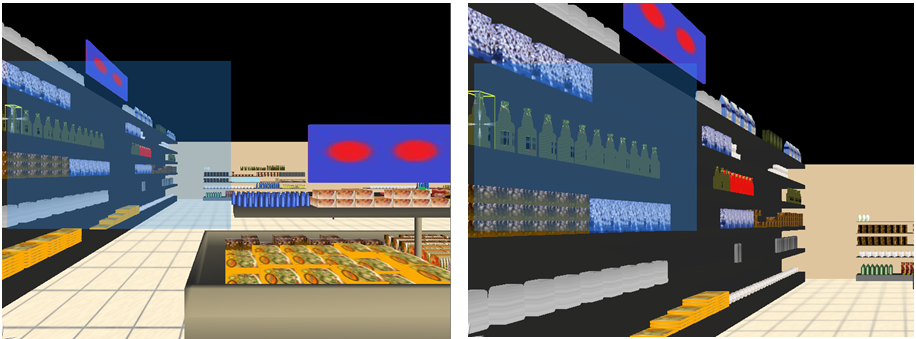Issues such as hand and tracker jitter negatively affect user performance with 3D selection techniques based on the ray-casting metaphor. This makes it difficult for users to select objects that have a small visible area, since small targets require high levels of precision. This project introduces a new approach to address this issue that uses progressive refinement of the set of selectable objects to reduce the required precision of the task. We have designed several different techniques that use this design:
SQUAD (Sphere-casting refined by QUAD menu)
This selection technique uses two distinct refinement phases. In the first phase, the user specifies a volume containing the target object. The user then refines the initial selection progressively by selecting the subset of objects containing the target from a four-item menu displaying all the remaining objects, until the target is finally selected. SQUAD makes it possible to accomplish precise selection without requiring the user to use precise actions at any moment during the selection task.

Discrete Zoom
The discrete zoom technique uses 2D menus for specification of the zooming area, discrete actions to define when to zoom, and ray-casting. The user can choose to point directly to the object and select it, or to point to the region of the screen that contains it and perform zoom to increase the target size. Once the object is selected, the user goes back to the initial unzoomed view, and is able to perform other actions.

Continuous Zoom
The continuous zoom technique works in a similar way to discrete zoom, but instead of using quadrants for zooming, it zooms in the direction of the cursor continuously. This way, users can simply point roughly toward the object and zoom in until the target is large enough for selection.

Improved SQUAD Technique
In order to SQUAD, we are focusing on improving its two phases separately (Sphere-casting, and the QUAD menu). Our initial goal is to reduce the size of sphere without necessarily increasing the necessary precision in pointing. In order to achieve that, we implemented a version of bubble cursor to automatically resize the sphere based on the distance of the pointer from objects in the environment and the user. We also improved the QUAD menu by reducing the time required for selecting a quadrant by using simple gestures to select a quadrant (e.g., flicking the device to the left selects the left quadrant). While this does seem to improve the overall time of selection of a quadrant, it still requires a few iterations for selecting objects in the menu if the environment is too cluttered. To solve this issue, we implemented the original 2D version of bubble cursor for the menu selection. Finally, SQUAD also requires the target object to be visually distinct, since its second selection phase is done out-of-context. To solve this, we made the background of the menu transparent and now show a line that connects the proxy objects in the menu to the original object in the scene. Figure 26 shows the new menu phase of our technique.

Improved Zoom Technique
This technique combines the best features of the continuous and discrete zoom techniques. To maintain low precision requirements, we used discrete zoom steps: every time the user presses the zoom in/out button, a pre-determined amount of zoom will be used and a short animation is shown, like in the Discrete Zoom technique. To reduce visual search, zoom will always occur in the direction of the cursor, like in the Continuous Zoom technique. A zoom preview window indicates what part of the screen the next level of zoom will show.

Journal Articles
Design and evaluation of 3D selection techniques based on progressive refinement Journal Article
In: International Journal of Human-Computer Studies, vol. 71, pp. 785 - 802, 2013, ISSN: 10715819.
3DUI 2010 Contest Grand Prize Winners Journal Article
In: IEEE Computer Graphics and Applications, vol. 30, no. 6, pp. 86 - 96, c3, 2010, ISSN: 0272-1716.
Conferences
Rapid and accurate 3D selection by progressive refinement Conference
IEEE Symposium on 3D User Interfaces (3DUI) 2011, IEEE IEEE, Singapore, Singapore, 2011, ISBN: 978-1-4577-0063-7.
